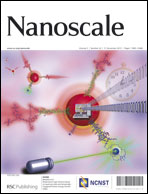Tuning the 3D plasmon field of nanohole arrays†
Abstract
Modern photonics is being revolutionized through the use of nanostructured plasmonic materials, which confine light to sub-diffraction limit resolution providing universal, sensitive, and simple transducers for molecular sensors. Understanding the mechanisms by which light interacts with plasmonic crystals is essential for developing application-focussed devices. The strong influence of grating coupling on electromagnetic field distribution, frequency and degeneracy of plasmon bands has now been characterized using hexagonal nanohole arrays. An equation for nanohole arrays was derived to demonstrate the strong influence of incidence and rotation angle on optical properties of 2D plasmonic crystals such as nanohole arrays. Consequently, we report experimental data that are in strong agreement with finite difference time-domain (FDTD) simulations that clearly demonstrate the influence of the grating coupling conditions on the optical properties (such as plasmon degeneracy and bandwidth), and on the distribution of the plasmon field around nanohole arrays (including tuneable penetration depths and highly localized fields). The tuneable 3D plasmon field allowed for controlled sensing properties and by increasing the angle of incidence to 30 degrees, the resonance wavelength was tuned from 1000 to 600 nm, and the sensitivity was enhanced by nearly 300% for a protein assay using surface plasmon resonance (SPR) and by 40% with surface-enhanced Raman scattering (SERS) sensors.


 Please wait while we load your content...
Please wait while we load your content...